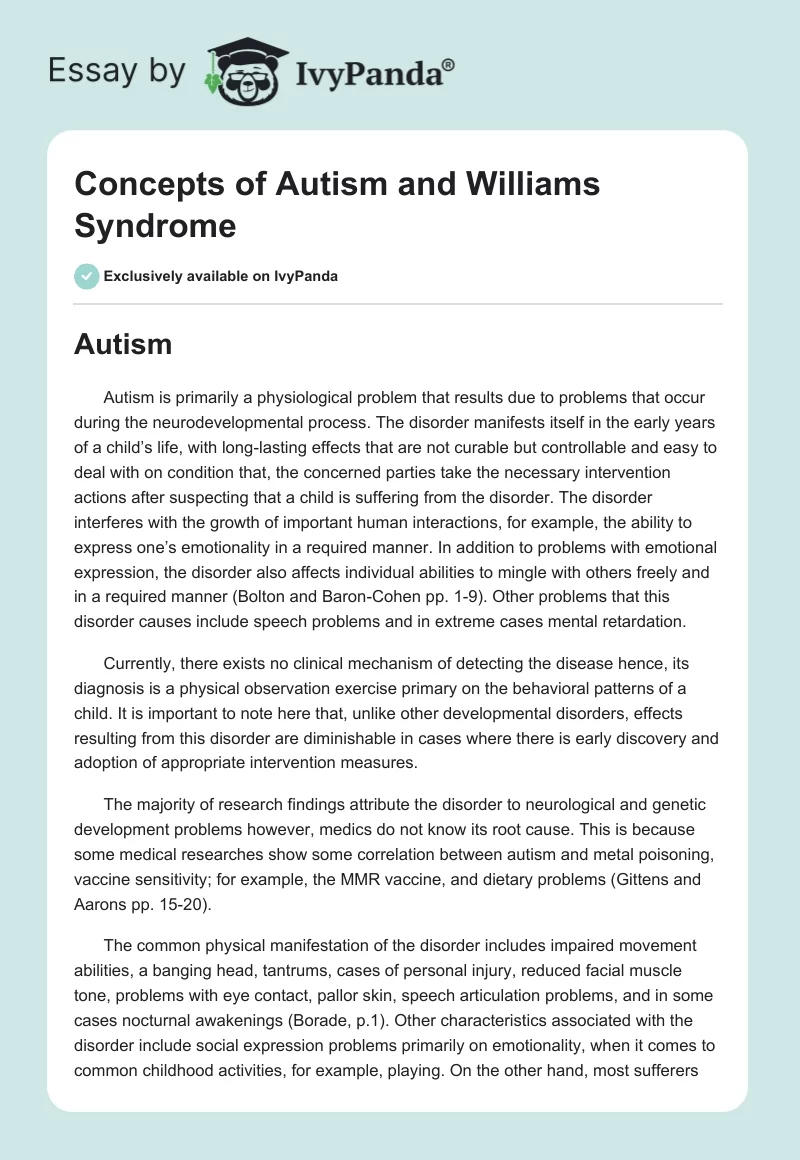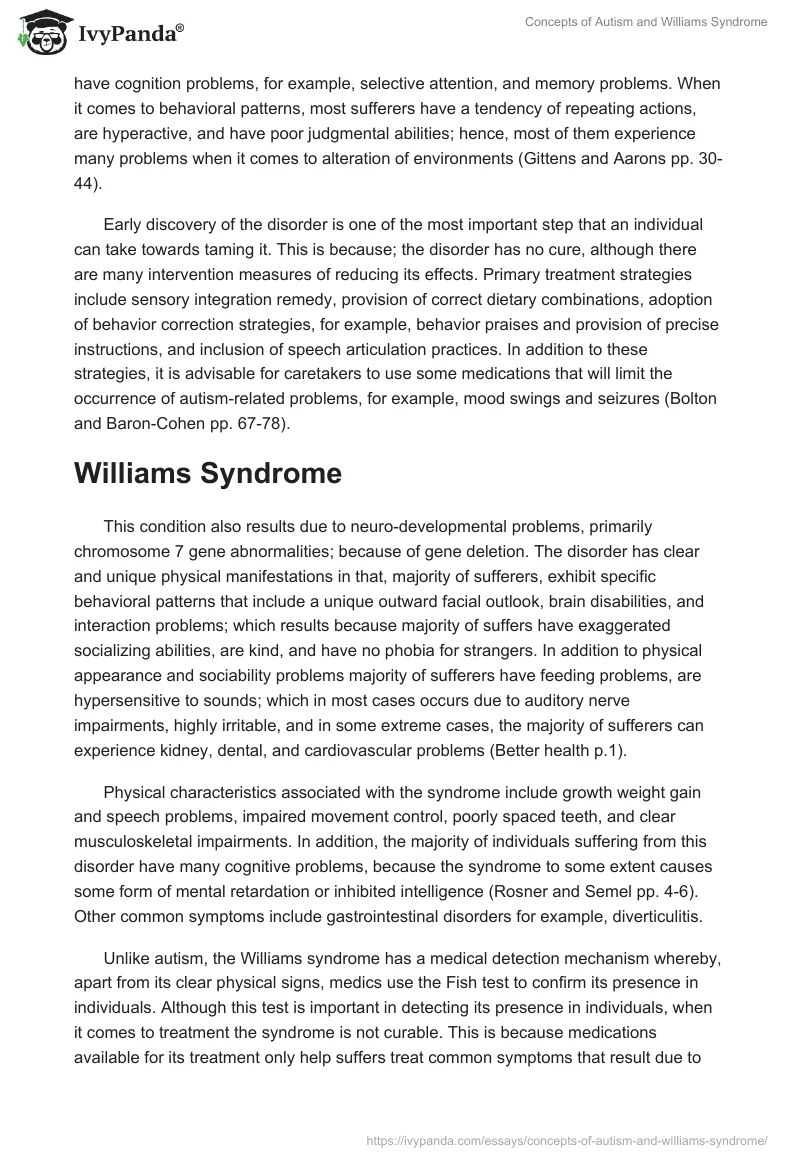Autism
Autism is primarily a physiological problem that results due to problems that occur during the neurodevelopmental process. The disorder manifests itself in the early years of a child’s life, with long-lasting effects that are not curable but controllable and easy to deal with on condition that, the concerned parties take the necessary intervention actions after suspecting that a child is suffering from the disorder. The disorder interferes with the growth of important human interactions, for example, the ability to express one’s emotionality in a required manner. In addition to problems with emotional expression, the disorder also affects individual abilities to mingle with others freely and in a required manner (Bolton and Baron-Cohen pp. 1-9). Other problems that this disorder causes include speech problems and in extreme cases mental retardation.
Currently, there exists no clinical mechanism of detecting the disease hence, its diagnosis is a physical observation exercise primary on the behavioral patterns of a child. It is important to note here that, unlike other developmental disorders, effects resulting from this disorder are diminishable in cases where there is early discovery and adoption of appropriate intervention measures.
The majority of research findings attribute the disorder to neurological and genetic development problems however, medics do not know its root cause. This is because some medical researches show some correlation between autism and metal poisoning, vaccine sensitivity; for example, the MMR vaccine, and dietary problems (Gittens and Aarons pp. 15-20).
The common physical manifestation of the disorder includes impaired movement abilities, a banging head, tantrums, cases of personal injury, reduced facial muscle tone, problems with eye contact, pallor skin, speech articulation problems, and in some cases nocturnal awakenings (Borade, p.1). Other characteristics associated with the disorder include social expression problems primarily on emotionality, when it comes to common childhood activities, for example, playing. On the other hand, most sufferers have cognition problems, for example, selective attention, and memory problems. When it comes to behavioral patterns, most sufferers have a tendency of repeating actions, are hyperactive, and have poor judgmental abilities; hence, most of them experience many problems when it comes to alteration of environments (Gittens and Aarons pp. 30-44).
Early discovery of the disorder is one of the most important step that an individual can take towards taming it. This is because; the disorder has no cure, although there are many intervention measures of reducing its effects. Primary treatment strategies include sensory integration remedy, provision of correct dietary combinations, adoption of behavior correction strategies, for example, behavior praises and provision of precise instructions, and inclusion of speech articulation practices. In addition to these strategies, it is advisable for caretakers to use some medications that will limit the occurrence of autism-related problems, for example, mood swings and seizures (Bolton and Baron-Cohen pp. 67-78).
Williams Syndrome
This condition also results due to neuro-developmental problems, primarily chromosome 7 gene abnormalities; because of gene deletion. The disorder has clear and unique physical manifestations in that, majority of sufferers, exhibit specific behavioral patterns that include a unique outward facial outlook, brain disabilities, and interaction problems; which results because majority of suffers have exaggerated socializing abilities, are kind, and have no phobia for strangers. In addition to physical appearance and sociability problems majority of sufferers have feeding problems, are hypersensitive to sounds; which in most cases occurs due to auditory nerve impairments, highly irritable, and in some extreme cases, the majority of sufferers can experience kidney, dental, and cardiovascular problems (Better health p.1).
Physical characteristics associated with the syndrome include growth weight gain and speech problems, impaired movement control, poorly spaced teeth, and clear musculoskeletal impairments. In addition, the majority of individuals suffering from this disorder have many cognitive problems, because the syndrome to some extent causes some form of mental retardation or inhibited intelligence (Rosner and Semel pp. 4-6). Other common symptoms include gastrointestinal disorders for example, diverticulitis.
Unlike autism, the Williams syndrome has a medical detection mechanism whereby, apart from its clear physical signs, medics use the Fish test to confirm its presence in individuals. Although this test is important in detecting its presence in individuals, when it comes to treatment the syndrome is not curable. This is because medications available for its treatment only help suffers treat common symptoms that result due to the abnormality. Common treatment therapies include dietary control for example, on the amount of calcium consumed. In addition, physical and speech therapy are other important remedies for mitigating effects resulting from the syndrome (Levin p.1).
References
Better health. The Williams syndrome. Better health: Genetic health, April. 2008. Web.
Bolton, Patrick and Baron-Cohen, Simon. Autism: the facts. New York: Oxford University Press,1993. Web.
Borade, Gaynor. Physical characteristics of children with autism. Buzzle.2009. Web.
Gittens, Tessa and Aarons, Maureen. The handbook of autism: a guide to parents and Professionals. London: Routledge publishers, 1992. Web.
Levine, Karen. The Williams syndrome information for teachers. Williams Syndrome Association. 2008. Web.
Rosner R. Sue and Semel, Eleanor. Understanding Williams syndrome: behavioral patterns and Interventions. New Jersey: Lawrence Erlbaum associates, 2003. Web.


